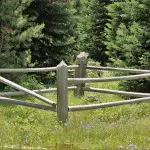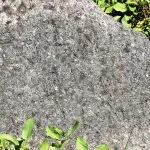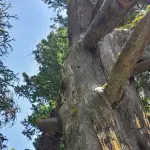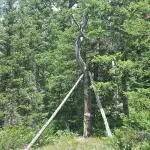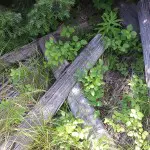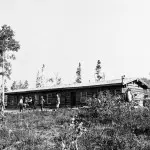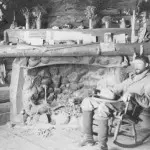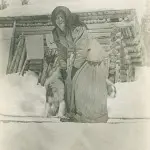In 1886 John Dudley Sargent first visited Jackson Hole and resolved to return to homestead. He returned home to Machias, Maine where he married Adelaide Crane and had two children, a son and a daughter. In 1889, the young family was in Jackson Hole and construction began on their 10-room house they named Merymere. Accompanying Sargent to help complete the work was partner Robert Ray Hamilton, a friend from Yale. That winter, Sargent and his family returned to Maine for the birth of their third child, a daughter. They returned to Jackson Hole in the summer of 1890 and started their roadside business in earnest. Located along the military road leading to Yellowstone’s south entrance, they catered to overnight visitors hoping to stop for a meal and a bed. The road construction had only just begun, so traffic and business were slow.
It seemed that the harsh winters in the valley drove the family to winter in Salt Lake City, where a fourth child was born. The Sargents would have one son and four daughters over the course of ten years, the last being born at the ranch in 1895. In 1891 tragedy struck the young family, and as a result rumors would begin that would plague Sargent for the rest of his life. His partner and friend, Ray Hamilton was found drowned after a hunting expedition. Sargent and Hamilton had made plans to hunt near the pot holes area of the valley, south of Signal Mountain. Sargent returned from the trip and had apparently risen the alarm that Hamilton was still missing. Several search parties were organized and all agreed that when Hamilton was found, a fire would be lit on the butte nearby. Thus, Signal Mountain received its name. Hamilton was found, hung up in the saddle, near a particularly dangerous channel of the Snake River. It is assumed that he drowned when the saddle turned while trying to ford at the dangerous location. Immediately, rumors spread that Sargent had given his friend intentional directions to cross at this spot, knowing that survival was unlikely. The validity of this account was never proven, but it appeared that valley residents were already wary of Sargent. It would seem little evidence was needed to label him as a suspicious character.
Sargent put the rumors behind him and led a happy, almost idyllic life in his beautiful corner of the valley. Other than the Sheffields, ten miles south at Moran, the Sargents held the only patented land along Jackson Lake. Only eight years later in 1897, the happy days for the family would end in another tragedy blanketed by yet more mystery. In the early spring, a couple Yellowstone troops stopped by the roadhouse, expecting to be invited in for food and intending to carry mail south to Moran. This was the usual course for these men, and they were surprised to find Sargent hesitant to let them inside. As no written record of this interaction survives, we don’t know what caused the men to hurry to Moran and announce their concerns about the Sargent family. Whatever was said to the town residents, it caused a small posse to hike up to the Sargent home, only to find John missing and Adelaide confined to her bed due to a severe injury.
It was thought that she had fractured her pelvis, but the cause of the injury was suspect. However, it was clear that she had been in need of medical attention, and that was withheld. The small posse realized that Adelaide would not survive in her condition and they attempted to transport her the 50 miles south to Jackson. They were only five miles out of town when Adelaide’s struggle ended and she died. Stories circulated that upon her last minutes, she was asked how she came to be so injured. She claimed she had “much to tell” if she survived, but otherwise the truth would stay with her; the cause of her injuries was never determined.
Adding more speculation to an already suspicious set of events, John was absent from the valley for the next two years. It is thought that he abandoned all five of his children, that they were eventually transported back to Maine to live with relatives. However, the second and fourth children, both daughters, appear to have remained in Jackson Hole. In 1899, Yellowstone troops happened upon Sargent near his property with his fourth child, Katherine, on a toboggan. As their report details, once he became aware of their presence he abandoned the toboggan and took off into the woods, evading capture. Katherine was brought into Moran where she lived with neighbors for some time. It is unclear where his second child Mary was at the time. Sargent would disappear again from the valley for some time.
He reemerged in 1906-1908 with a second wife, Edith. It is not known when or where they married, as it is thought that he was not living at Merymere in the preceding years. As usual, rumors spread that John was paid by Edith’s family to marry her and take her away. His daughter Katherine reappeared on the ranch for a time, but none of his other children were seen or heard from. It is believed they remained with family members in Maine. Edith and John lived mostly alone on the ranch, John being labeled a pariah by the rest of the valley. They led quiet lives, as the roadhouse was often bypassed for more comfortable lodgings in Moran. Neighbors and travelers reported seeing Edith sunbathing naked around the property, which led to rumors that John took her clothing to prevent her from running away. Others claimed she was simply a “child of nature,” and nothing was unusual about this behavior, other than it being highly unconventional for the time. More often, those passing through would see Edith in a large pine tree playing the violin. Music was highly valued by both Edith and John, who owned a grand piano and a Victrola. There was reportedly a nail embedded into the tree to hold her instrument when she was not playing.
In 1913 Edith was brought to San Diego, California for unknown reasons. John returned to his ranch in Jackson Hole and lived alone. Later that year Edith was committed, by persons unknown, to a sanatorium. Meanwhile at Merymere, John was living a very isolated life. This fact is confirmed by the two weeks that passed before he was found dead in his cabin, by travelers passing by who could smell the decomposing body from the road. They found him sitting in his rocking chair, a string tied to his toes and to his rifle. Within arm’s reach was his prized Victrola, with the record “Ye Who Have Yearned Alone” having completed its last rotations. It is thought that when the music ceased, so did John Dudley Sargent. When his body was found, several days later, he was covered in cotton and buried directly outside. His grave still exists, marked by a stone and fencing built by Slim Lawrence, founder of the Jackson Historical Society and Museum. His estate was later sold with the cabin and all of his belongings to Harry Wagner.
Wagner then sold the property to William Lewis Johnson in 1926; Johnson constructed a new ranch to the south of Sargent’s old homestead. Upon Johnson’s death in 1936, Alfred and Madeline Berolzheimer purchased the property and renamed it the AMK Ranch. Today, the AMK still exists, along with the Johnson and Berol buildings. The Sargent homestead site has disappeared except for Sargent’s grave marking the general location of his cabin. For those up for a challenge, Edith’s “violin tree” can also be found on the property, north of the grave and above the lakeshore.
TIMELINE
1886: John Dudley Sargent first arrives in Jackson Hole on vacation and decides to return to settle in the valley. At this point, only a small handful of individuals are living in the valley.
1890: Sargent arrives on his ranch for the first time with his wife and two children. His friend and business partner Robert Ray Hamilton joins the family and assists with construction of a 10-room cabin the Sargents call Merymere.
1891: Ray Hamilton doesn’t return from a hunting trip with Sargent. He is later found drowned, with his foot still in the stirrup after falling off his horse into the Snake River. A fire is lit on a nearby butte as a signal to other search teams that Hamilton has been found. Signal Mountain receives its name.
1897: Yellowstone troopers stop by Merymere on their way into Moran. They usually stop in for food and to bring mail into town, it is a routine event. They find Sargent acting unusually cagey and decide to head into Moran. Once in town they mention the encounter to the locals. A small posse goes up to the ranch to find Mrs. Sargent in bed with a broken pelvis, and John Sargent missing. They attempt to get Mrs. Sargent into town to see the doctor, but she dies 45 miles into the 50 mile trip. Sargent disappears from the valley for a few years, leaving his five children behind.
1899: Sargent reemerges in Jackson Hole and is pursued on foot by Yellowstone troops through the woods. He is spotted with his young daughter, who he abandons on a toboggan. The daughter is brought into Moran to live with neighbors. The rest of his children are assumed to be in Maine with extended family members. Another daughter is reported to be in Jackson Hole, but her whereabouts are unknown.
1906-1908: John Sargent appears back at Merymere with a new wife, Edith. They live a quiet, isolated life but are regularly seen on their homestead by neighbors and tourists traveling the military road to Yellowstone’s south entrance.
1913: Edith Sargent is brought to San Diego, California. It is unknown if she lives alone or with family, why she leaves John in Jackson Hole. It is thought that he brings her to California, but returns to Jackson Hole. Months later she is brought to a sanitarium. Around this time, John Sargent commits suicide in his cabin. He is found sitting in the living room, with a string tied to his foot and to his rifle’s trigger. At his side is his prized Victrola, having finished its last song. It is thought that when the song was over, Sargent pulled the string and ended his life. He was buried in a shallow grave directly outside his cabin, which was later marked and fenced by Slim Lawrence. Sargent’s grave is the only remaining piece of his cabin and homestead which were later torn down. The grave is located just north of the AMK Ranch.
1926: William Lewis Johnson purchases the property and constructs a new main cabin south of the old Sargent homestead. Merymere was left to the elements and eventually disappeared.
1936: Alfred and Madeline Berolzheimer purchased the ranch from the Johnson family and renamed it the AMK Ranch. They constructed a large main residence and used the Johnson building for a guest house.
2015: The Berol and Johnson cabins still remain on the property. Today the AMK Ranch is a research center for the University of Wyoming.
Text by Samantha Ford, Director of Historical Research and Outreach
